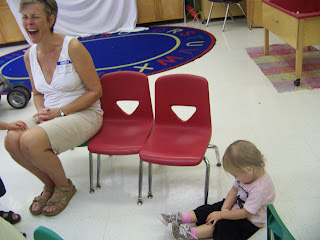Scribbling!
Scribbling is a very important developmental task. Crawling obviously leads to walking, but many other important kinds of brain development are fostered when a child learns to crawl. So it is with scribbling. Scribbling not only leads to drawing, scribbling provides essential brain development leading to other advanced mental capacities. Children naturally move on to image making, just as crawling children naturally move on to walking. For a child's intellect and personality to develop there needs to be opportunities to explore, be curious, be rewarded for this with recognition and praise.We encourage scribbling by providing a place and materials, by acknowledging the work, and by discussing the work in a nonjudgmental ways. In the child's mind scribbling is not meant to be artwork in the sense that we think of artwork. Scribbling for a child is more about action than about creating a product. It is process. It is activity. I never ask, "What is it?" I might say, "Wow, this looks like you are having fun. Your crayon is really going fast." As the child gets closer to the stage of image making, I might , say, "This part looks neat, can you tell me about it?" As children become verbal and are able describe their work, their minds are learning to think in imaginary and abstract ways. It is our ability to imagine that makes us human. It makes us care. It makes it possible for us to take responsibility.
For the rest of our lives it is our imaginations that allow us to predict the consequences of scribbling on walls and every other thoughtless and considerate act of expression. Our imaginations help us avoid thoughtless acts that bring sadness from those we care about. Our imaginations allow us to be creative, to solve everyday problems, and to make the world a better more joyous place for ourselves and those we care about.
Written by: Marvin Bartel
J. liked the dump truck and the chalk. He went over to the rocksalt bin and picked out the dump truck and brought it back and began loading up the chalk. Then he would dump the chalk and drive over it with the truck (which created a pretty neat effect.) Thank you to J.'s mom who emailed me this information!






Ordinary Moments,
Extraordinary Possibilities!
An acknowledgement that even small, seemingly mundane moments hold great potential for surprise, wonder, discovery and learning. One only needs to observe a child marveling at a stick floating in a puddle to understand the profound significance that ordinary moments can have. Through attentive and unhurried observation of a child's focus and intent, we allow ourselves to subtly bolster and deepen the child's experience. Often a teacher or parent’s timely expression of interest and support, coupled with a child's initial enthusiasm, can lead to an extended and more reflective exploration of these moments. Our challenge as educators is to participate in the moment without controlling it. We seek to remain present and engaged in the experience as it unfolds, following the child's evolving path of interest rather than focusing on a predetermined outcome or plan.

This is why wandering in The Wonder Studio is so valued! As the children finish their experience with the chalk pastels, S. begins to arrange some of the chairs in a line. He asks his mother to join him in his line.
She is of course, a willing partner! Now, we see a head approaching the scene. Everyone is aware of the empty seat. What will happen?
S. stands up as C. comes closer. They look at each other and try to interpret what the other's intention might be.
C. Sits down on the floor with her head down. She obviously wants to be a part of this experience and seems to want S.'s approval.
I find this moment to be extraordinary in that it seems to be a beautiful sort of Dance between 2 souls. Niether one communicating audibly with words but the nonverbal communication is very apparent. Learning to "read" another person's nonverbal language is critical to developing empathy and understanding. While most would just see children "playing", we know that an extrordinary moment just took place.
Practicing conflict resolution with Mom's help.
H. yearns for a social interaction with her peer. They work together for a moment with one brush.
H.'s Mom points out that J. doesn't appear to be enjoying the interaction and H. relinqueshes the brush. Not a missed opportunity for learning about nonverbal communication and/or empathy.
Stirring, and Stirring, and Stirring the Brew!!!!
My Moment in the Spotlight!
I saw the moment during which he drew the connection between moving the snake on the projector and looking on the wall to see the shadow move. He got really excited about that. J.'s Mom Comments
An important accomplishment for a child is the process of sorting/classifying. Many children enjoy lining things up! It gives them a chance to explore lines as well as a sense of order and organization. She spent much time looking for lizards that would fit into her line.
Here, a mom is pointing out one of the lizards. Notice Z. is paying attention as well!







































































